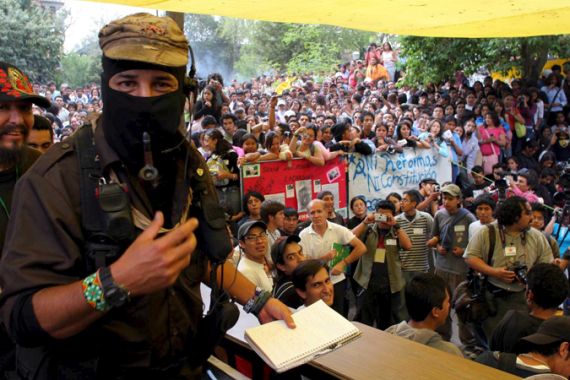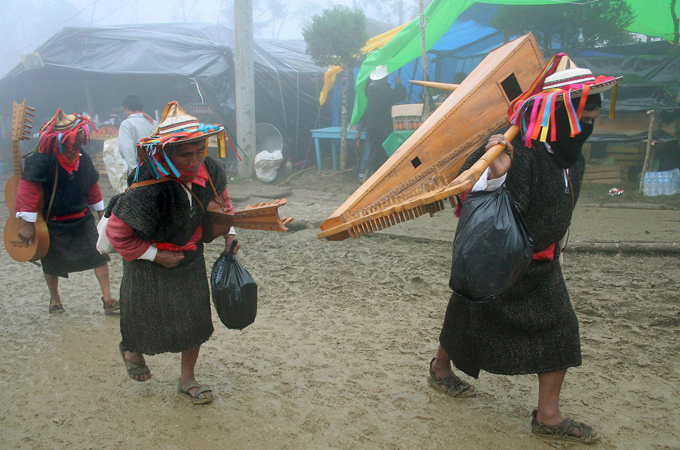Zapatistas: The war with no breath?
The poverty-stricken people of Chiapas are still marginalised and experiencing great hardship, 17 years after rebellion.

 |
| Zapatista rebels, mostly indigenous peasants, wanted access to farm land, health care, education and political rights for the poor, near-feudal state [EPA] |
Tuxtla Gutierrez, Dec 31, 2010 – Seventeen years after rallying cries for land and freedom sparked the Zapatista rebellion, a quiet mist cloaks the mountains of Chiapas state in southeast Mexico.
Unlike previous years, there are no major celebrations, no marches or fiery public speeches by rebels fighting for the region’s long-neglected indigenous people.
Hailed by the New York Times in 1994 as the “first postmodern Latin American revolution”, some commentators in Mexico and beyond now consider the Zapatistas a spent force, a rebellion with strong rhetoric and little capacity, lacking the ability to deliver beyond its rural base.
“The transformations the movement tried to make did not arrive,” says Gaston Garcia Flores, a professor of philosophy who studies social movements at the Universidad del Mar in southern Mexico.
But, after being pushed around for more than 500 years, others think it is naïve to consider the Zapatistas down for the count.
Everything can change, on New Year’s Day
The rebellion itself began on New Year’s Day 1994, when some 3,000 poorly armed indigenous rebels seized six towns in Chiapas, Mexico’s southernmost state.
Few disputed their right to be angry.
Poverty in the area, as defined by the international dollar-per-day threshold, hovered around 56 per cent when the rebellion began, with many families lacking access to basic healthcare and education, while a small elite controlled much of the arable land, in near-feudal conditions.
In rural communities, an estimated 20 per cent of children died before the age of five.
The Zapatistas timed the rebellion to coincide with the implementation of NAFTA, the North American Free Trade Agreement, between Canada, the US and Mexico.
They called NAFTA a “death sentence”, as it removed from the Mexican constitution Article 27, a provision won during the first Mexican revolution in the early part of the last century, designed to guarantee collective property rights to those who worked the land.
Vocal opposition to NAFTA gained the rebels support from trade unions and other social movements who tried – and failed – to stop the agreement.
However, it was their style of speaking, specifically the words of the group’s iconic pipe-smoking public face, Subcomandante Marcos, who expressed something new and electrifying for an insurgent group.
Unlike Marxist revolutionaries who preceded them, the Zapatistas did not speak in certainties; their words were more poetry than political polemics.
“They had a lot of political imagination and successfully used the Internet and new communications technology,” says professor Flores, between drags on a cigarette at an outdoor café.
The Zapatistas wanted “to listen and learn about struggles … to shake the country from below and turn it on its head” and to create “a world where many worlds fit”. And those ideas resonated, in Mexico and beyond.
People of the Sun
In the days following the rebellion, some 100,000 people rallied in Mexico City chanting, “we are all Zapatistas”.
The Mexican army, apparently caught flat-footed by the fighting, countered soon after New Year’s Day, pushing the poorly armed rebels out of the towns they had seized.
“Without that broader popular support, the government would have destroyed them in the most violent way,” says Blanche Petrich, a journalist with La Journada newspaper in Mexico who has covered the Zapatistas since the uprising.
Peace negotiations followed a unilateral ceasefire by the Zapatistas. The group pressed for indigenous autonomy over traditional territories, and better access to health, education, justice, democracy and land.
With much fanfare and relief, the Mexican government and the Zapatistas signed the San Andres Accords in 1996, designed to bring peace to the region by dealing with root causes of the conflict.
The government, however, never implemented the accords. “The Zapatistas decided to stop the negotiations due to a lack of political will,” says Miguel Alvarez, a former member of the national commission for negotiation, who worked closely with the Catholic Church in mediating between the Zapatistas and the government.
The Mexican military maintained a large force in the area during this period with harassment – including well-documented rapes and killings by the military or paramilitary allies of large land-owners.
The corn and sickle rebellion
To push for the spirit of the accords, the Zapatistas took their show on the road in 2001, travelling throughout Mexico, pushing for an end to military harassment in Chiapas as well as reinforcing their message of improving indigenous rights across the country.
At the climax, up to 400,000 people, and much of the world’s media, packed the main square in Mexico City to hear the Zapatistas’ message. But, as in San Andres, popular support did not bring institutional change from the government and the Zapatistas headed back to Chiapas.
This time around, they decided not to wait for the state to grant autonomy. In 2003, they announced the creation of Juntas de Buen Gobierno (good government committees) to cement a form of social organization autonomous from the Mexican state.
“[The Juntas] are the best expression of the San Andres accords, an example of how to rule an indigenous community without discrimination,” says Alvarez, who now heads an NGO in Chiapas. The Juntas mediated disputes within Zapatista territories, through a parallel justice system, and attempted to coordinate better development to improve living standards in the communities.
Tasks like growing corn, building indigenous-run schools and creating artisan cooperatives are hardly the stuff of front page headlines. The movement was being effectively marginalised by the Mexican government, leading the Zapatistas to refocus and re-enter the greater imagination of the national and international community.
Grassroots rebranding
To recapture some attention, they launched La otra campana (the “Other Campaign”) in 2006, with Subcommandante Marcos rebranded as “delegate zero”, traveling across the country on a motorbike to build grass-roots support, as an alternative campaign to presidential elections which happening at the same time.
“The contrast between the Other Campaign and the first march [in 2001] was enormous,” says Petrich.
By most accounts, the Other Campaign failed. It did not ignite a grassroots national movement. And only a few hundred people attended rallies in Mexico City.
Marcos used the platform to consistently bash Andres Manuel Lopez Obrador, a left-leaning presidential candidate. Marcos advised his supporters not to vote at all.
Lopez Obrador did not become president, in an election marred by accusations of irregularities and fraud.
“A lot of people who could have voted in that moment, especially the youth, did not,” says professor Flores. “Marcos divided the left with his sectarianism and did a good job for the right.”
After weeks of street demonstrations in support of Lopez Obrador, Felipe Calderon took the presidency and promptly declared an all out war on drugs, leading to the spiraling violence Mexico now faces.
The rhetoric of silence: a change in tact?
Since the Other Campaign, the Zapatistas have stayed away from the press and Marcos, who is believed to be a former communications professor, seems to have been put out to pasture by the group’s indigenous leaders.
Unconfirmed reports from a well-placed source in San Cristobal de las Casas allege that Immanuel Wallerstein, a distinguished leftist academic, attempted to get Marcos a job at Binghamton University in the US. However the university was unwilling to entertain the idea.
In the Zapatistas’ base communities, reporters have not been allowed interviews with key movement activists, since 2008. But some long-time observers don’t think that is a major issue of any concern.
“Despite the fact that Zapatistas are no longer in the media, it does not mean that they are disappearing, rather they are trying to get better conditions of living,” says Alvarez, the former mediator.
“The Zapatistas’ problems have not been solved but the fact that they have recovered their dignity [as indigenous people] has been their first big achievement.”
In the Zapatistas’ base communities, populated by an estimated 100,000 indigenous supporters, poverty is still widespread. Key activists, who say they have struggled for a better world for the past seventeen years, still cannot afford shoes for their kids, forcing them to walk and work barefoot in the mud.
However there have been tangible, material successes, not just advances in dignity and other abstract concepts.
Pablo Gonzalez Casanova, the former rector of Mexico’s National Autonomus University (UNAM), conducted a public health study comparing Zapatista communities in Chiapas to their non-Zapatista counterparts.
Zapatista health providers extended coverage to 63 per cent of all expectant mothers, double the average for non-Zapatista communities in the area. Seventy-four per cent of Zapatista homes have access to toilets, as opposed to 54 per cent in non-Zapatista homes.
Zapatista communities also have significantly better statistics for infant mortality than other rural areas in Chiapas.
“The position of women in the communities has increased greatly,” Petrich says. “They used to be kept in the margins, basically treated like domestic animals. Now the role they play is crucial. This is not a minor result,” she says, adding that the Zapatistas have also made major strides in education.
As a broader political movement, they managed to light the fire of resentment boiling within Mexico. However, Petrich believes the Zapatistas “did not go as far as they expected”.
Even seventeen years to the day after the first shots were fired, the legacy of the movement remains unclear. A popular Zapatista slogan, plastered on posters around their communities, demands “everything for everyone, nothing for ourselves”.
Perhaps the Zapatistas gained something in their small corner of the world, even if they didn’t get everything for everyone.
Follow Chris Arsenault On Twitter: @AJEchris